PROTECT YOUR DNA WITH QUANTUM TECHNOLOGY
Orgo-Life the new way to the future Advertising by AdpathwayPumpkins are long-maturing, taking time to develop their thick-skinned, fleshy, hefty fruits. They soak up the sun and moisture of summer to ripen late in the season and just in time to enchant autumn evenings. Whether you’re getting inspired to grow your own pumpkins, running a little behind on sowing, or experiencing a short growing season, fast-developing pumpkins let us enjoy the fruits without quite as long a wait time.
Many pumpkins mature in 90 to 100 days, with some taking up to 120 days. For pumpkin varieties to plant in July, look for those that mature earlier (even a month or so) to accelerate the harvest. They still take time, and there’s no rushing a good pumpkin, but 70 to 80 days to maturity marks an achievable yield. Late varieties usually produce smaller fruits on more compact vines.
To start the winter squashes this month, make sure the allotted harvest time falls before your first anticipated frost date. The frost-sensitive vines slow in chilly temperatures and die back in freezing conditions. Their ideal growing range is between 70-90°F (21-32°C). For mild climates, the harvest can run into early October before seasonal cooling.
In cold climates, a July pumpkin planting may cut it close with early frosts unless you have fast-growing varieties and cold protection. Opt for bushing types that grow quickly with manageable vines. Try a frost cloth cover for added protection if cool temperatures are in the forecast. Planting them in mounds or raised beds may provide a little extra warmth.
Black Kat Pumpkin

Casperita Pumpkin

Jack Be Little Pumpkin

Jack Be Little Pumpkin Seeds
‘Black Kat’
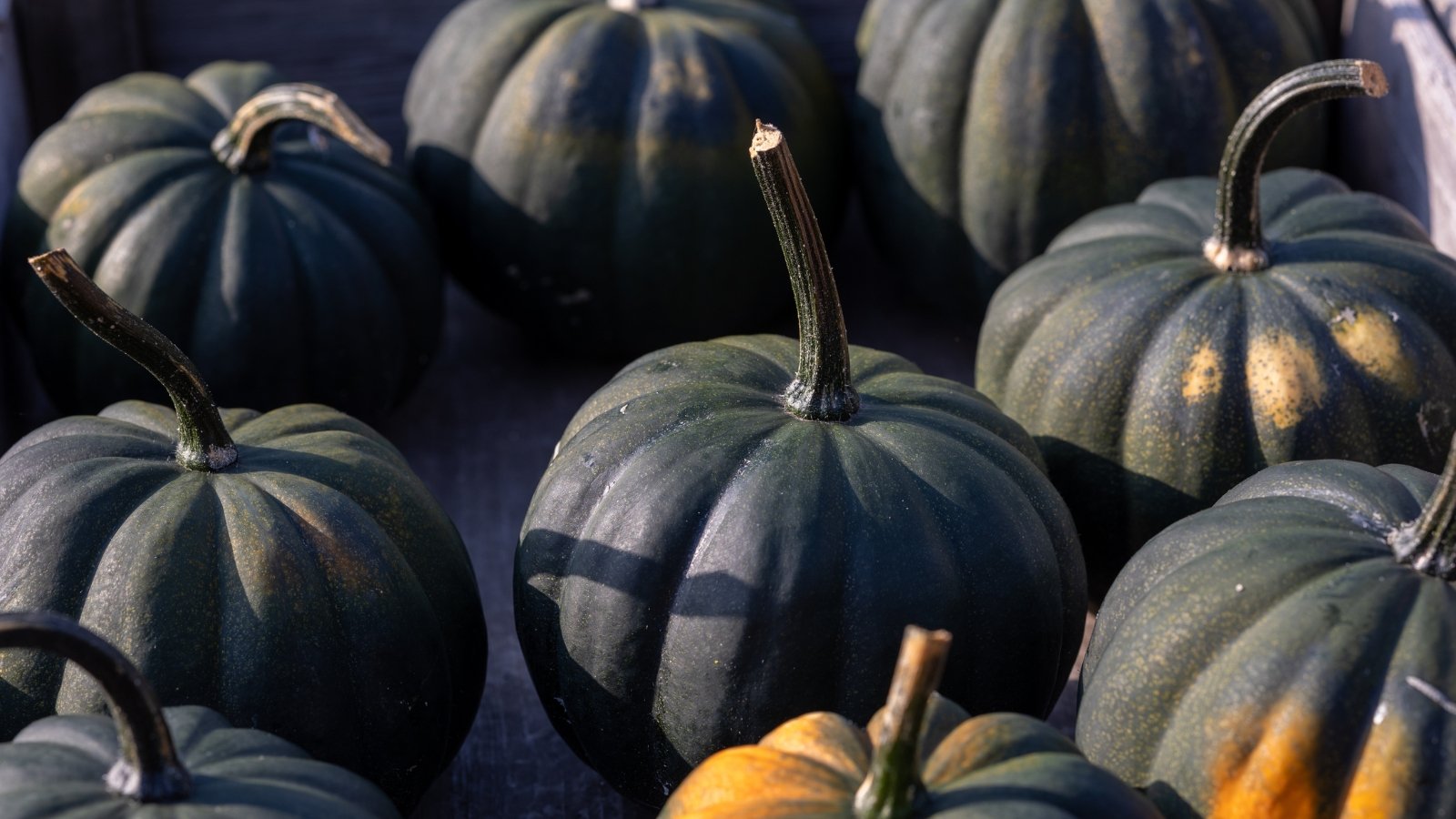 Bold contrast and early ripening make them a standout.
Bold contrast and early ripening make them a standout.‘Black Kat’ is spell-binding with a dark green-to-black exterior and heavy ribbing. From stem to base, the dramatic variety transitions from green to near black as it ripens.
Each ‘Black Kat’ miniature pumpkin reaches three and a half to four and a half inches across and weighs one to two pounds. They have bright orange flesh with high contrast to the dark skin. Not only striking in the display, they’re also edible.
To add to ‘Black Kat’s merits are powdery mildew resistance and, best regarding a late planting, they mature early for harvesting in 75 to 80 days. Fast-growing vines make this pumpkin variety ideal for planting in July.
Feature ‘Black Kat’ among ornamental grasses, flowering perennials, and annuals in fall displays. They’ll captivate grouped with other gourds and squashes for dynamic variation.
‘Batwing’
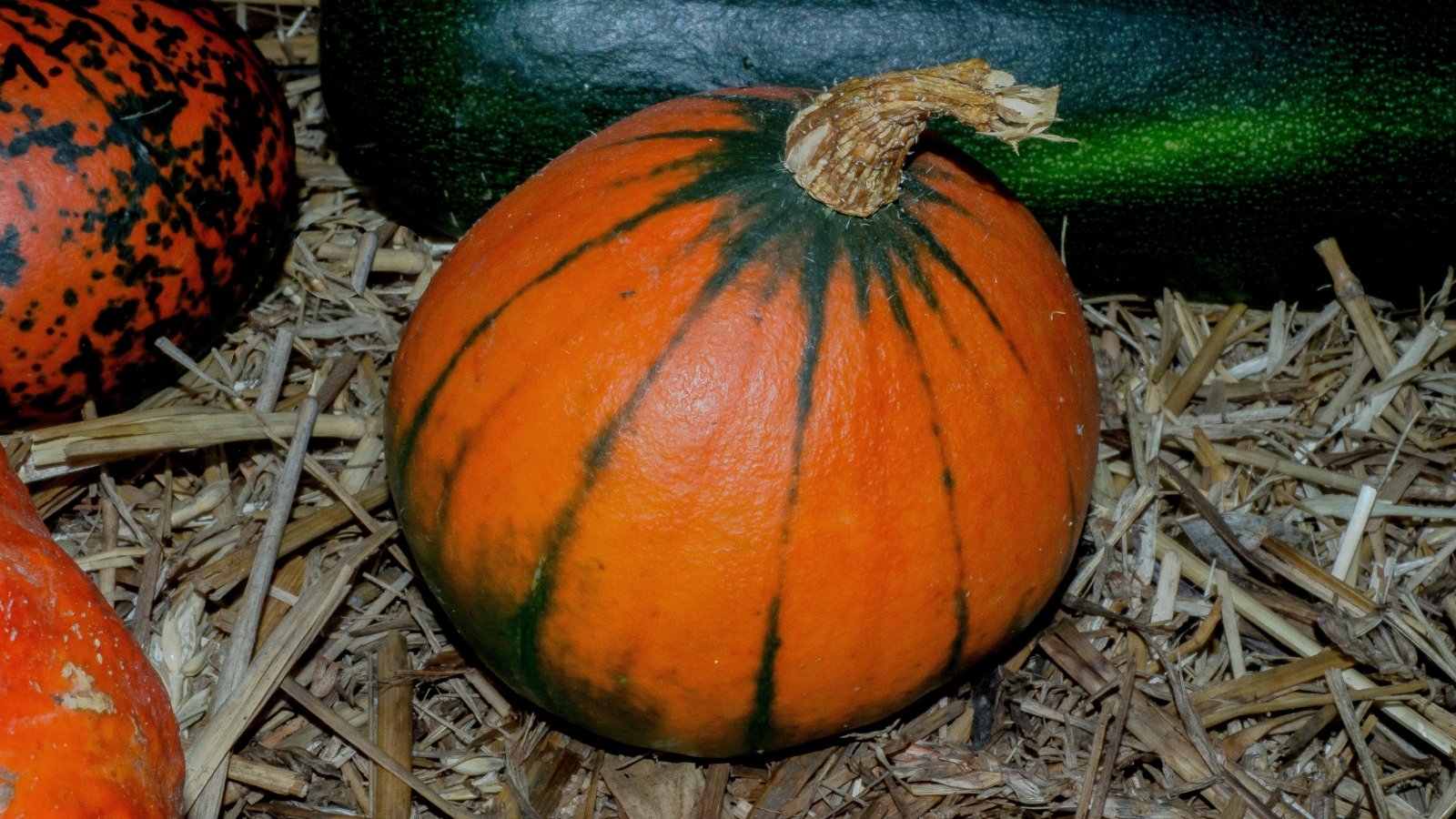 Tiny pumpkins flash bold green wings across bright orange.
Tiny pumpkins flash bold green wings across bright orange.‘Batwing’ brings the cool factor with globes dipped in black-green, creating a dramatic swinging, winged pattern. The three-to-four-inch pumpkins vary in their green markings, with some mostly green and others mainly orange with green-black at their base.
The small, showy fruits are ready in 80 to 90 days. A perfect, fast-growing pumpkin variety for sowing in July, ‘Batwing’ shows the best coloration with a late sowing and early harvest.
‘Casperita’
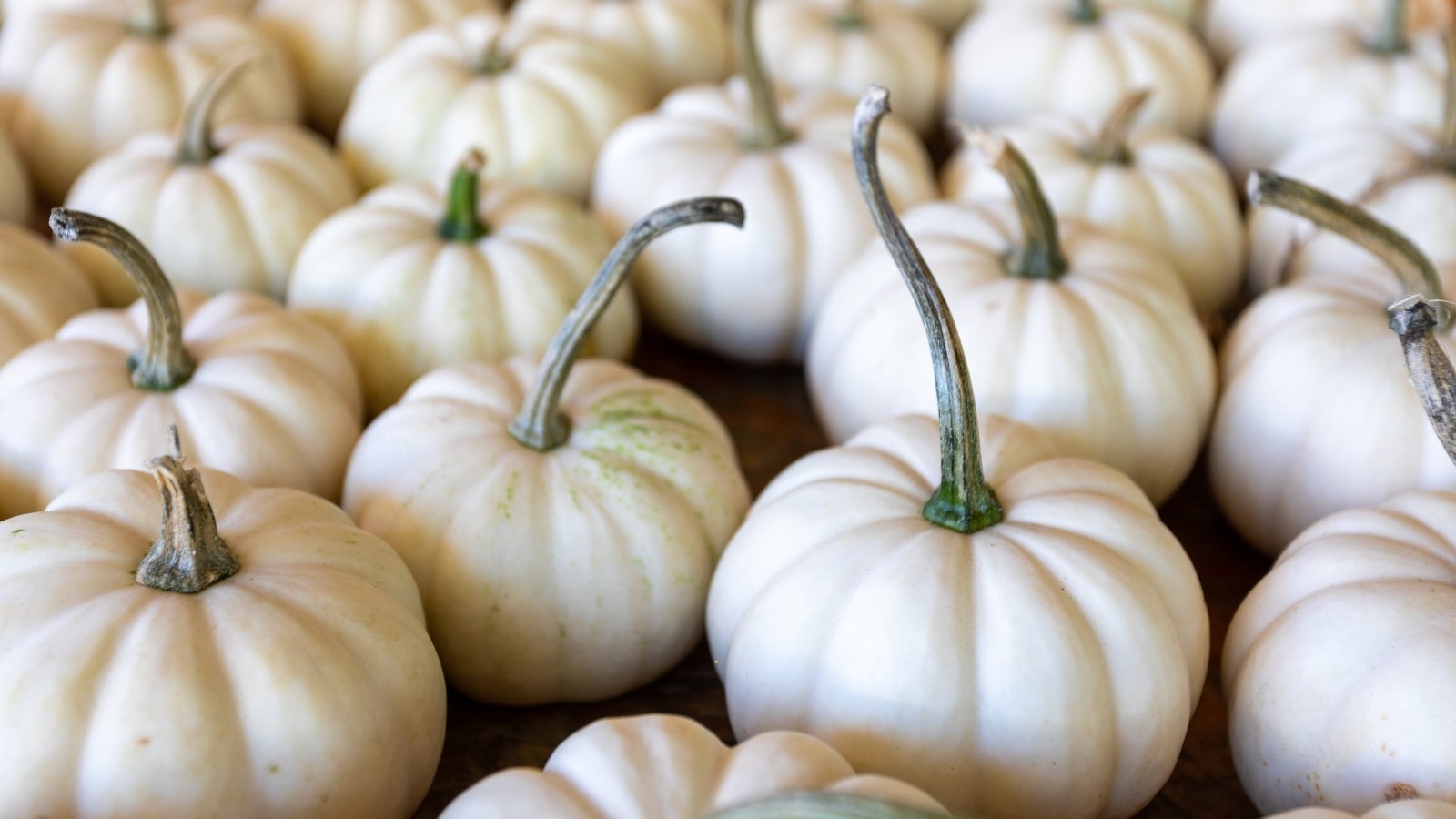 Bright white pumpkins glow next to bold fall colors.
Bright white pumpkins glow next to bold fall colors.‘Casperita’ is the prettiest little ghost of a pumpkin. In pure white, the rounds are crisp, clean, and a blank slate for painting and decorating. Pair them with more colorful selections for a bright contrast or with neutral winter squashes in buff and peach for a soft, clean look.
‘Casperita’ fruits are four to four and a half inches wide and weigh less than a pound. Green stems stand out against the milky exterior and add visual interest. Leave three inches of stem attached when harvesting and storing pumpkins to preserve the integrity of the fruit.
‘Casperita’ is productive and resists powdery mildew and watermelon mosaic virus. Like ‘Black Kat,’ they mature in just over 75 days and are edible.
‘Neon’
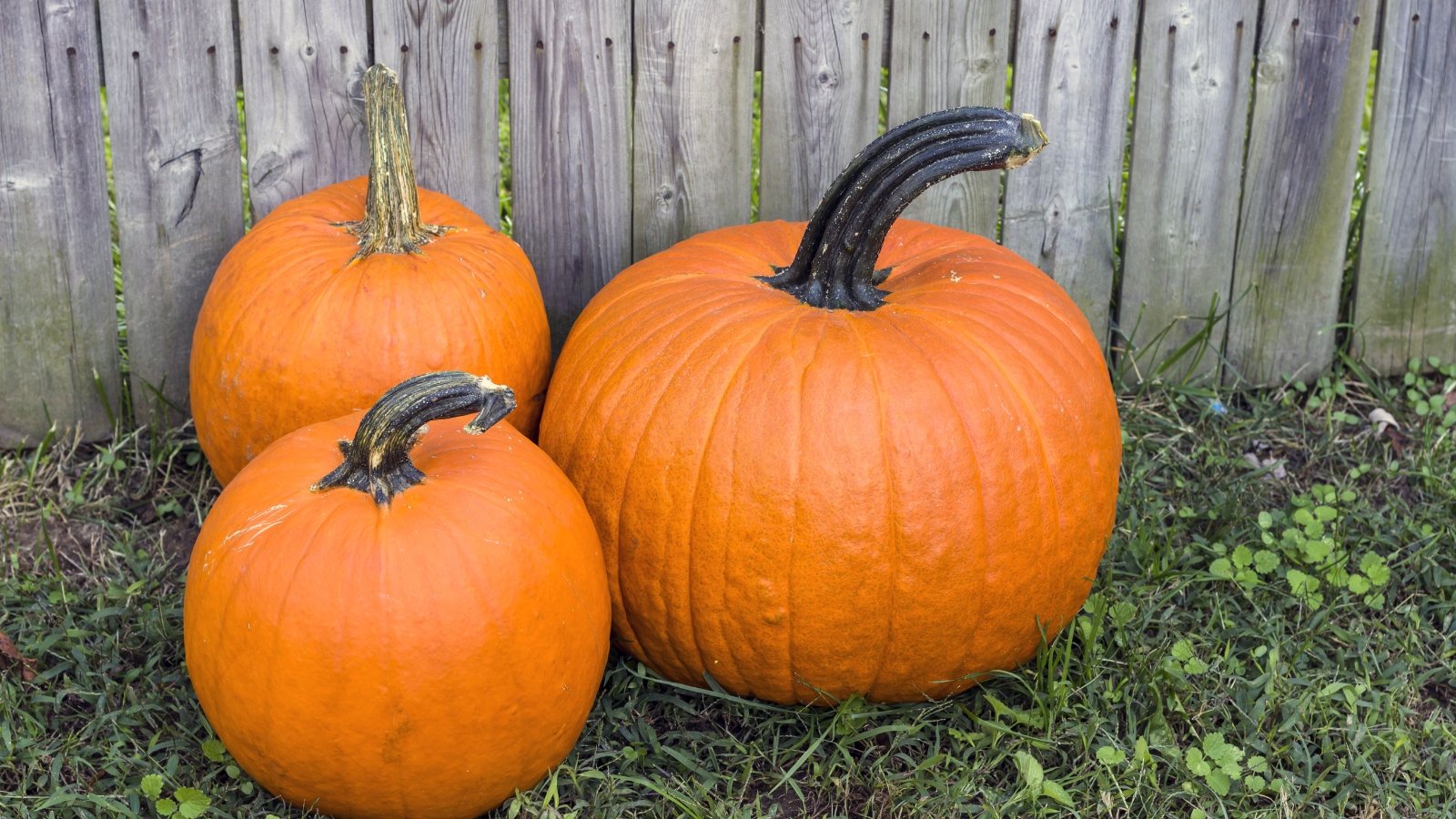 Bright orange rounds ripen early for porch-ready charm.
Bright orange rounds ripen early for porch-ready charm.‘Neon’ glows right in time for the harvest season. Ready in 70 to 80 days, the little pumpkins are ready to light up the front porch or dinner table. Suitable for decorating, they’re also flavorful in pies and soups. The semi-bushing variety is manageable in small spaces and for growing vertically.
Because it colors early, ‘Neon’ is a contender for picking early and small. The jack-o-lantern rounds in bright orange weigh seven to eight pounds at full size, with a girth of about 10 inches. Black handle stems hold their color and create a rich contrast to the orange-gold skin.
‘Autumn Gold’
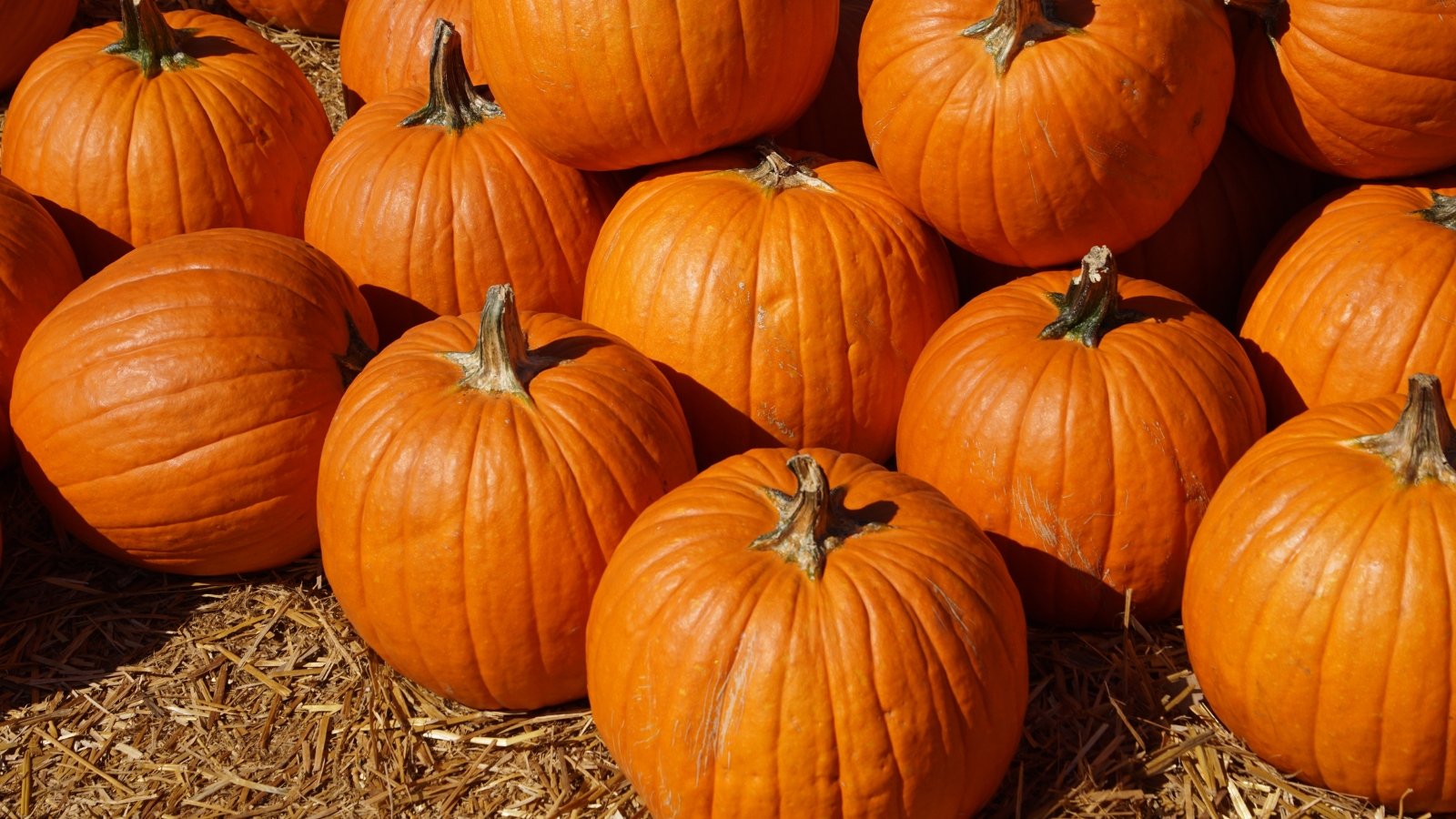 Big, bold pumpkins ripen fast on compact, tidy plants.
Big, bold pumpkins ripen fast on compact, tidy plants.This vigorous, productive bush-type variety produces three to five sizeable pumpkins per plant. It shows that a weighty pumpkin can develop in under 100 days. The 7 to 10-pound rounds mature in 90 days.
‘Autumn Gold’ is an All-America Selections winner for its early-to-color and early-to-harvest qualities. Look for the bright yellow-orange on uniform fruits and harvest before full size.
‘Jack Be Little’
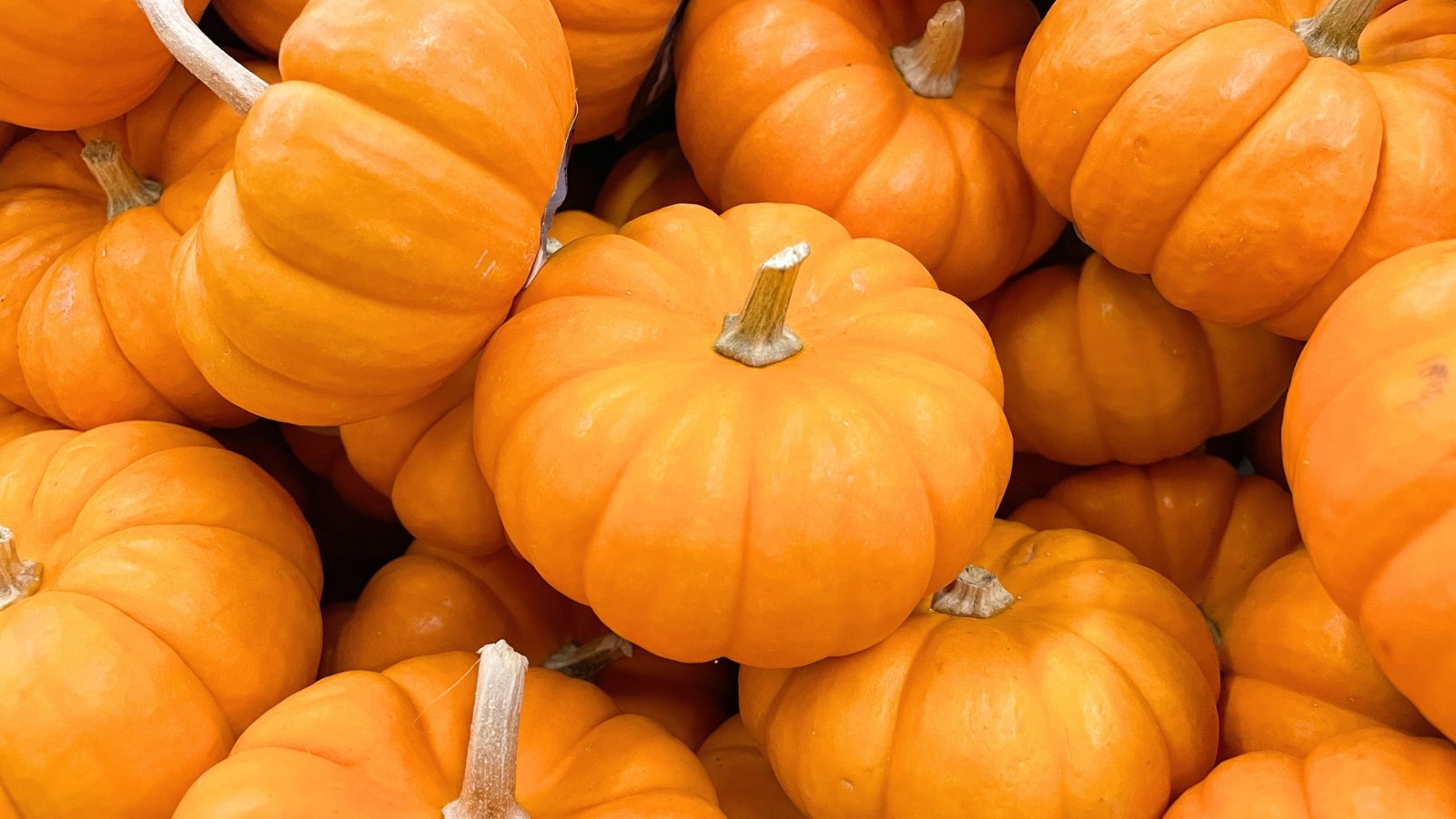 It holds up for months without losing its fresh appeal.
It holds up for months without losing its fresh appeal.Jack Be Little’ is a charming mini and a hearty producer with six to ten fruits per plant. These pumpkins join our small, faster-developing varieties at three to four inches in diameter and two inches high.
In addition to prime decor in a pot or tablescape, ‘Jack Be Little’ is a good eating pumpkin and a personal-sized bowl. They have an extended shelf life and can be stored for up to a year.
Tidy, compact vines suit containers, making the perfect doorstep welcome. Use a five-gallon or larger pot that’s at least 18 inches deep. ‘Jack Be Little’ matures in 95 days.
‘Sugar Pie’
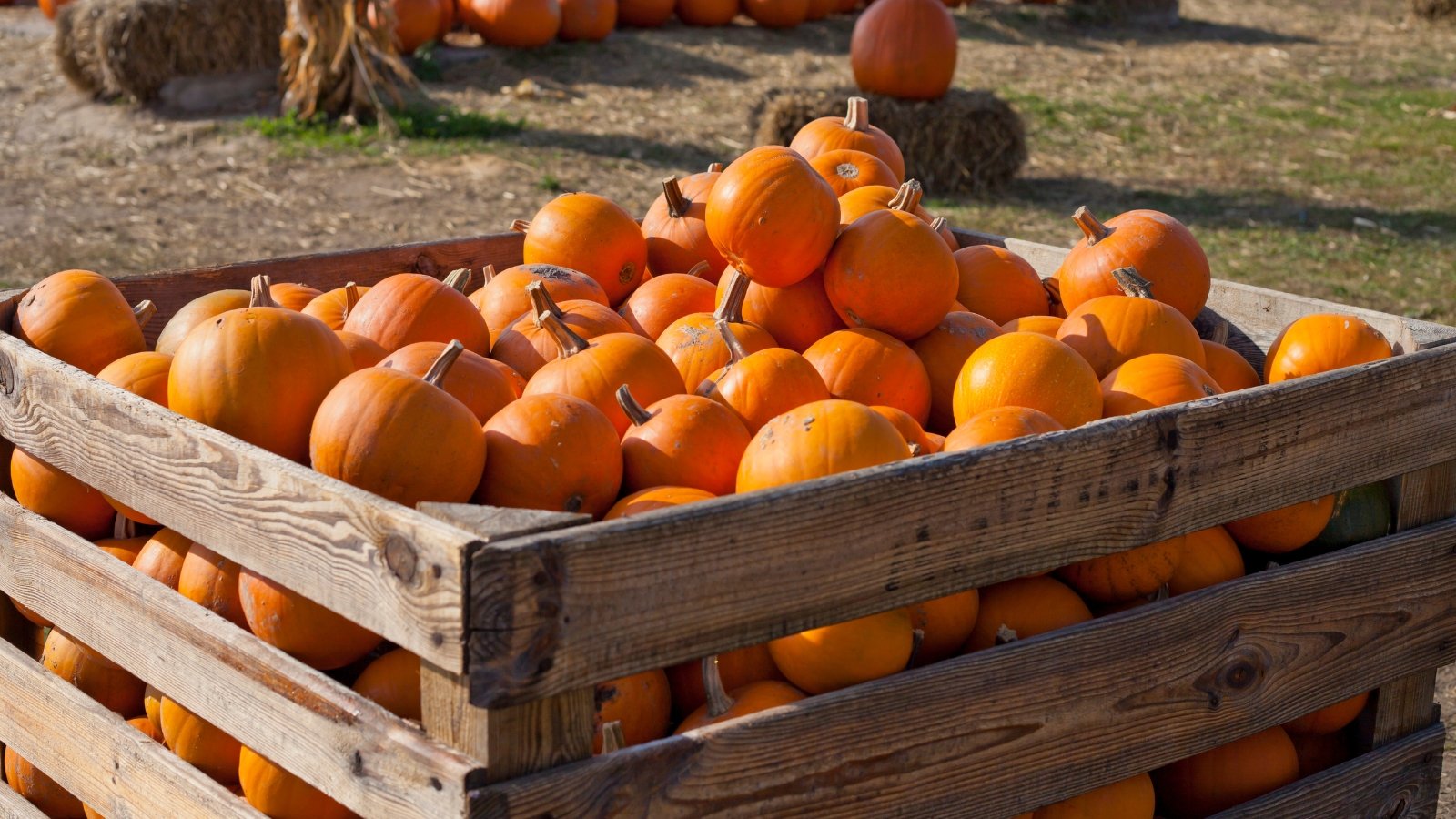 Red-orange rounds cook up silky and rich.
Red-orange rounds cook up silky and rich.‘Sugar Pie’ is an heirloom that’s a winning combination of performance and particularly sweet, tender flesh. On the early end, the fruits mature in 90 days, but on the long side, they can take up to 115 days. Sow this pumpkin variety in July if you have a long growing season or live in a frost-free climate.
The “sugar pumpkin” from the 1800s is still a favorite today for its sweet taste and months-long storage life. Sugar pumpkins are a description for winter squashes that are particularly sweet with dense, fine flesh.
‘Sugar Pie’s’ red-orange rounds grow six to seven inches around and weigh four to five pounds. Intended for cooking, their smooth, thick, fine-grained interior is versatile in the cuisine, from pies to savory dishes. They’re also carveable for jack-o-lantern festivities.
‘Spark’
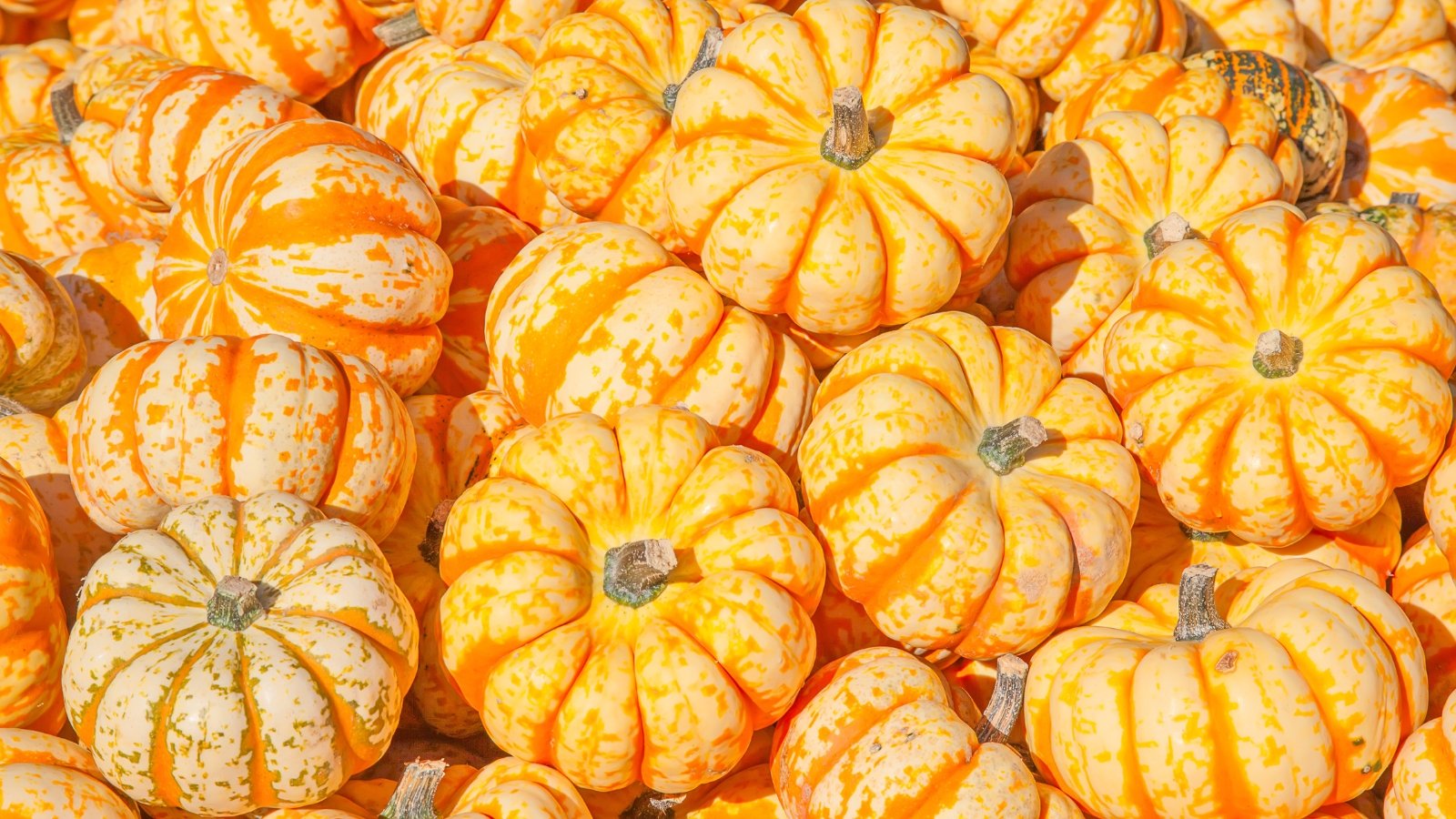 Striped beauties brighten up any autumn corner.
Striped beauties brighten up any autumn corner.‘Spark’ brightens with bright golden yellow mini-pumpkins with orange stripes and splashes. The flattened fruits are very uniform, at three and a half inches in diameter and two inches tall. The small squashes weigh only about half a pound.
‘Spark’ has sturdy stems from vigorous, productive vines that resist powdery mildew. They peak in about 90 days. Save this one for pure ornament rather than fresh eating.
‘Red Kuri’
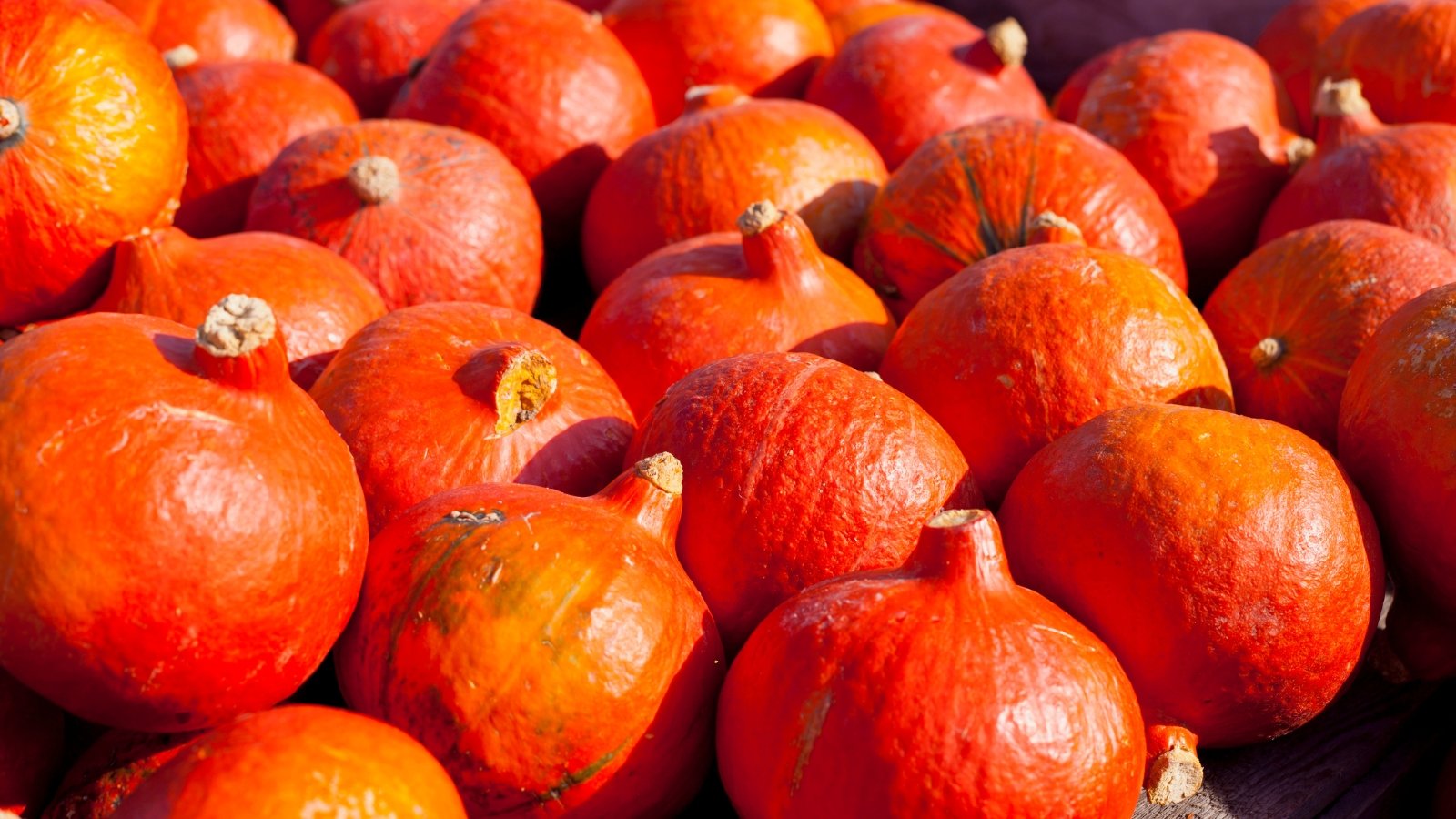 Early-ripening squash thrives in smaller garden spaces.
Early-ripening squash thrives in smaller garden spaces.A different species of winter squash (and not really a pumpkin), ‘Red Kuri’ is as sweet as one and has rich, red-orange, smooth skin. A Japanese variety famed for its creamy texture and chestnut flavor, they make a fun addition to the pumpkin patch. With compact vines and slightly earlier development (95 days), they’re a fit for short-growing seasons and later plantings.
‘Red Kuri’ performs well in containers and small spaces, producing three-to-four-pound teardrop-shaped fruits. Use them for steaming, roasting, and baking.


 1 week ago
12
1 week ago
12





















 English (US) ·
English (US) ·  French (CA) ·
French (CA) ·